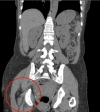Late-Onset Thyroid Hormone Resistance Following Total Thyroidectomy for Papillary Thyroid Cancer
- PMID: 40236334
- PMCID: PMC11998621
- DOI: 10.7759/cureus.80673
Late-Onset Thyroid Hormone Resistance Following Total Thyroidectomy for Papillary Thyroid Cancer
Abstract
Thyroid hormone resistance (RTH) is a rare disorder characterized by impaired cellular responsiveness to thyroid hormones, leading to discordant thyroid function tests and varied clinical manifestations. We present the case of a 43-year-old Cuban-American female patient who presented with dizziness, vertigo, repeated falls, and a severe headache following a minor fall. Additional symptoms included nausea, vomiting, photophobia, cold intolerance, generalized body aches, and fatigue. Her medical history was significant for total thyroidectomy for papillary thyroid cancer, multiple sclerosis (MS), pituitary macroadenoma, Cushing's disease, and polycystic ovary syndrome (PCOS). Post-thyroidectomy, she remained on high-dose levothyroxine (400-750 mcg daily). However, laboratory tests showed persistently elevated thyroid-stimulating hormone (TSH) levels, hence raising suspicion for RTH. This case highlights the challenges of diagnosing and managing RTH, a rare endocrine disorder often resulting from mutations in the thyroid hormone receptor-beta (THB) gene. RTH is characterized by inappropriately normal or elevated TSH despite high thyroid hormone levels, reflecting tissue-level resistance. This case underscores the complexities of identifying RTH in the setting of multiple comorbidities and a history of thyroidectomy. It also emphasizes the need for clinician awareness of atypical presentations of RTH, particularly in patients with extensive endocrine and systemic histories.
Keywords: delayed presentation; genetic mutations in thyroid hormone signaling; hyperthyroxinemia with normal tsh; thyroid cancer treatment outcomes; thyroid hormone resistance (rth).
Copyright © 2025, Kapil et al.
Conflict of interest statement
Human subjects: Consent for treatment and open access publication was obtained or waived by all participants in this study. Conflicts of interest: In compliance with the ICMJE uniform disclosure form, all authors declare the following: Payment/services info: All authors have declared that no financial support was received from any organization for the submitted work. Financial relationships: All authors have declared that they have no financial relationships at present or within the previous three years with any organizations that might have an interest in the submitted work. Other relationships: All authors have declared that there are no other relationships or activities that could appear to have influenced the submitted work.
Figures






Similar articles
-
Coexistence of resistance to thyroid hormone and papillary thyroid carcinoma.Endocrinol Diabetes Metab Case Rep. 2016;2016:160003. doi: 10.1530/EDM-16-0003. Epub 2016 Mar 30. Endocrinol Diabetes Metab Case Rep. 2016. PMID: 27168936 Free PMC article.
-
Differentiated thyroid cancer in two patients with resistance to thyroid hormone.Thyroid. 2011 Jul;21(7):793-7. doi: 10.1089/thy.2010.0233. Epub 2011 Jun 7. Thyroid. 2011. PMID: 21649470
-
[Thyroid hormone resistance: variable clinical manifestations in five patients].Nuklearmedizin. 1997 Oct;36(7):250-5. Nuklearmedizin. 1997. PMID: 9441285 German.
-
Syndrome of resistance to thyroid hormone: insights into thyroid hormone action.Proc Soc Exp Biol Med. 1996 Jan;211(1):49-61. doi: 10.3181/00379727-211-43951. Proc Soc Exp Biol Med. 1996. PMID: 8594618 Review.
-
Thyroid hormone resistance.Ann Clin Biochem. 2006 Nov;43(Pt 6):431-40. doi: 10.1258/000456306778904678. Ann Clin Biochem. 2006. PMID: 17132274 Review.
References
-
- Hyperthyroidism and other causes of thyrotoxicosis: management guidelines of the American Thyroid Association and American Association of Clinical Endocrinologists. Bahn Chair RS, Burch HB, Cooper DS, et al. Thyroid. 2011;21:593–646. - PubMed
-
- The clinical significance of subclinical thyroid dysfunction. Biondi B, Cooper DS. Endocr Rev. 2008;29:76–131. - PubMed
Publication types
LinkOut - more resources
Full Text Sources
